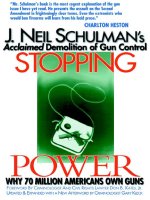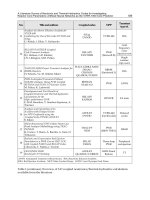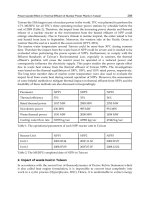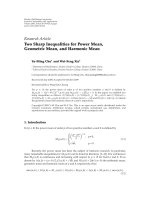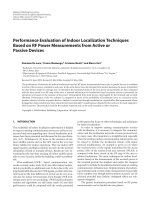Stopping Power- Why 70 Million Americans Own Guns pptx
Bạn đang xem bản rút gọn của tài liệu. Xem và tải ngay bản đầy đủ của tài liệu tại đây (753.87 KB, 320 trang )
1
Pulpless.Com™ Books by J. Neil Schulman
Novels
Alongside Night
The Rainbow Cadenza
Nonfiction
The Robert Heinlein Interview and Other Heinleiniana
The Frame of the Century?
Stopping Power: Why 70 Million Americans Own Guns
Book Publishing in the 21st Century,
Volumes One and Two
Short Stories
Nasty, Brutish, and Short Stories
Omnibus Collection
Self Control Not Gun Control
Collected Screenwritings
Profile in Silver and Other Screenwritings
J. NEIL SCHULMAN
STOPPING
POWER
WHY 70 MILLION AMERICANS OWN GUNS
FOREWORD BY CRIMINOLOGIST AND CIVIL-RIGHTS LAWYER DON B. KATES, JR.
A
FTERWORD BY CRIMINOLOGIST GARY KLECK
PULPLESS.
PULPLESS.
COM
COM
,
,
INC
INC
.
.
10736 Jefferson Blvd., Suite 775
Culver City, CA 90230-4969, USA.
Voice & Fax: (500) 367-7353
Home Page: http://
www.pulpless.com/
Business inquiries to
Editorial inquiries & submissions to
Copyright © 1994, 1999 by J. Neil
Schulman
All rights reserved. Published by arrange-
ment with the author. Printed in the
United States of America. The rights to
all previously published materials by J.
Neil Schulman are owned by the author,
and are claimed both under existing
copyright laws and natural logorights. All other materials taken from pub-
lished sources without specific permission are either in the public do-
main or are quoted and/or excerpted under the Fair Use Doctrine. Ex-
cept for attributed quotations embedded in critical articles or reviews, no
part of this book may be reproduced or utilized in any form or by any
means, electronic or mechanical, including photocopying, recording, or
by any information storage and retrieval system, without written permis-
sion from the publisher.
First published by Synapse˜˜Centurion, June, 1994
Pulpless.Com™ HTML Edition May, 1996
Revised Pulpless.Com™, Inc. Editions July, 1999.
Library of Congress Catalog Card Number: 99-60343
Trade Paperback ISBN: 1-58445-057-6
Acrobat PDF ISBN: 1-58445-058-4
HTML ISBN: 1-58445-059-2
Cover designed by CaliPer, Inc.
Cover Illustration by Eugene C. Herrera
To L. Neil Smith
Who Made Me Ashamed to Be Unarmed
Author’s Acknowledgements
Authors get all the credit, but they usually have help. Consider-
ing the many hours in which I have been educated on the subjects of
history, liberty, morality and ethics, justice, criminal justice and law
enforcement, firearms, and criminology, I would be remiss if I did
not pay acknowledgements to the personal instruction I received from
the following individuals: Sean Barrett, Alan Brennert, Steve Clar,
Culver City Police Chief Ted Cooke, Charles Curley, Robert Durio,
Art Eisenson, Harlan Ellison, Dan Feely, Elizabeth and Justin Feffer,
Manuel Fernandez, John Ferrero, Dennis Foley, David Friedman,
James Gatlin, Alan Gottlieb, Helen Grieco, Stephen Halbrook, Sylvia
Hauser, Robert and Virginia Heinlein, Steve Helsley, Randall Herrst,
Karl Hess, Ray Hickman, John Hosford, Phill Jackson, Dan Gifford,
Sal Grammatico, T.J. Johnston, Don B. Kates, Jr., Keith Kato, Bill
Keys, Gary Kleck, Peter Lake, Wayne LaPierre, Robert LeFevre, Rick
Lowe, Elodie McKee, Michael McNulty, John Milius, Armando
Miranda, Andrew Molchan, Jerry Pournelle, Dennis Prager, Leroy
Pyle, Pat O’Malley, Paxton Quigley, Ayn Rand, Robert Ray, Michael
D. Robbins, Rep. Dana Rohrabacher, Fred Romero, Murray Rothbard,
Jim Saharek, Randy Shields, Jay Simkin, Culver City Police Lt. Owen
Smet, Thomas Glenn Terry, Lance Thomas, Linda Thompson, Cathy
Tolley, Luis Tolley, Kent Turnipseed, Jim Waldorf, Aaron Zelman,
and, of course, my parents and family.
Additionally, for their direct guidance and help on this book, I’d
like to thank Léon Bing, John Douglas, Larry Freundlich, Kent
Hastings, Dafydd ab Hugh, Keith Kirts, Neal Knox, Victor Koman,
Samuel Edward Konkin III, Richard Kyle, Jared Lobdell, Tanya
Metaksa, Kate O’Neal, Ave Pildas and the students of the Otis De-
sign Group at Otis College of Art and Design, Dori Smith, and Albert
Yokum.
And, finally, a very special thank you to Brad Linaweaver and
Randy Herrst for assistance at the penultimate hour.
I know that some of the people I’m thanking disagree with my
views as expressed in this book. Tough. They have my gratitude any-
way. —JNS, 1994
Contents
Foreword by Don B. Kates, Jr 11
Preface 17
Introduction: as American as Guns 21
Sorties into Enemy Territory: the LA Times Op-Eds28
A Massacre We Didn’t Hear About 30
Joining Forces Against a Common Foe 34
Gun Fight at the 4 ‘n 20 Pie Shop 37
If Gun Laws Work, Why Are We Afraid? 40
Some Practical Arguments for an Armed Civilian
Population
43
A Time to Kill 44
140,000 LA Gun Owners Have Used Firearms Defensively 47
Do Guns Do More Harm or More Good ? 50
Q & A on Gun Defenses 56
How Does Japan Get That Low Crime Rate, Anyway? 67
An Overview of the Statistical Case 69
It’s Time to Take A Second Look at Murder 85
The War to Bear Arms in the City of the Angels 89
Remarks to the LA Board of Police Commissioners, 7/16/91
90
The Case for a Concealed Weapon’s License in Los Angeles
92
Remarks to the LA Board of Police Commissioners, 11/3/92
105
Guns Are Still “Equalizers” 108
Los Angeles Revises Concealed-Weapons Policy 111
How I (and 4 Million Friends) Successfully Fought City Hall .
113
The Thrill of My Life 117
The Second Amendment and the Right to Keep and
Bear Arms
119
Reply to the Executives of the ACLU of Southern California on
the Meaning of the Second Amendment 120
English Usage Expert Interprets Second Amendment 151
The Unabridged Second Amendment 153
Some Notes and Discussion on the Second Amendment 160
Reserve Militia Training and Regulation Act: A Proposal . 163
“With Liberty and Justice For All” 169
Open Messages to Judge Glen Ashman 170
A Rather One-Sided Debate on Gun Rights 179
Was Waco Warranted? 207
Does Hugging on TV Cause Real Violence? 213
Old Enough To Die, Old Enough To Live? 217
Instead of Crime and Punishment 221
If Execution Is Just, What Is Justice? 227
A Note To Freedom Activists 231
Ripostes And Counters 235
KNX Editorial Replies 236
Excerpts from a letter to Nadine Strossen, President, ACLU
239
Letter to Scientific American 242
A Reply to Joyce Brothers 244
Can You Trust Handgun Control, Inc.? 246
The Mark of Kane is on Firearms Reporting 251
Excerpts from a letter to the CEO of WAL*MART 256
When Doctors Call for Gun Seizures, It’s Grand Malpractice
259
What It Takes to Get Me to Put on a Yarmulke 266
Talk At Temple Beth Shir Shalom 267
More Stopping Power 273
A Rude Awakening 274
A Letter to The Economist 277
Cease Fire, Ed Asner 279
The Unconstitutional Bill of Rights 285
Afterword: Guns & Self Defense by Gary Kleck, Ph.D. 291
Sources and Recommended Further Reading 307
Pro-Firearms-Rights Organizations 313
Firearms Instruction 316
About J. Neil Schulman 315
Foreword
BY DON B. KATES, JR.
While still a student at Yale Law School, Don B. Kates, Jr.,
did civil rights work in the South, was a law clerk for William
Kuntsler, and drafted civil-rights legislation for the House Judi-
ciary Committee. From 1966 to 1975 he held various adminis-
trative positions with California Rural Legal Assistance and was
deputy director and director of litigation for the San Mateo
County Legal Aid Society, providing free legal representation
for the poor. He specialized in major constitutional litigation
and police misconduct litigation. In 1970 he was denominated
the nation’s outstanding legal services lawyer by the National
Legal Aid and Defender Association. He has also been a mem-
ber of the California Advisory Committee to the United States
Civil Rights Commission.
Professor Kates has acted as a police legal advisor to de-
partments in California and Missouri and has been a consult-
ant on firearms, firearms legislation, and civil rights legislation
to police departments and state and federal legislative commit-
tees. His articles on firearms have appeared in police and fire-
arms technical journals; and his articles on firearms laws and
“gun control” in general have appeared in Harper’s, The New
York Times, the Christian Science Monitor, the Civil Liberties
Review, the Criminal Law Bulletin, the Washington Post, the Los
Angeles Times, the St. Louis Post Dispatch, and various law
reviews and other publications. He is the author of Guns, Mur-
der, and the Constitution, and books he has edited include Re-
stricting Handguns: The Liberal Skeptics Speak Out and Fire-
arms and Violence.
Professor Kates has taught constitutional and criminal law
12 STOPPING POWER
at St. Louis University and as a criminologist is currently associ-
ated with the Pacific Research Institute. He maintains a largely
constitutional law practice in San Francisco and has recently
been litigating constitutional issues regarding California’s gun
laws. — JNS
Most Americans, including most gun owners, support reason-
able gun controls. As a criminologist, so do I — with the caveat
that even the best controls can only have marginal effects because
the real determinants of violence are cultural and socioeconomic.
The reason gun control remains a controversy is that the gun “con-
trol” movement has no interest in control, and no interest in work-
ing with the millions of gun owners who support control. The gun-
control movement is dominated, rather, by prohibitionists whose
ideologically motivated program obstructs society’s ability actu-
ally to control guns.
Exemplifying that obstruction is Washington D.C.’s ban on
handgun sales, passed at the urging of Handgun Control, Inc. (HCI)
and the National Coalition to Ban Handguns (NCBH). This ban
just drove the traffic underground, destroying the limited real con-
trol-value gun laws can have. When gun sales are legal, they’re
concentrated among gun dealers who can be required to register
or conduct background checks on buyers, and refuse sales to pro-
hibited persons such as felons and juveniles. Banning guns cre-
ated a thriving business, with black marketeers obtaining scores
of handguns in adjoining states and selling them on D.C.’s streets
to anyone with the money to buy.
The situation will be even worse if HCI and NCBH attain their
goal of a federal handgun ban. In addition to importing millions of
handguns, the black marketeers will produce modern handguns in
pot-metal copies. Though such a gun could only fire perhaps 300
shots before exploding, any competent machinist can fabricate one
using tooling no more sophisticated than that found in millions of
home workshops. Pot-metal guns would actually be less expen-
sive than commercially manufactured guns are today — being pro-
duced without safeties, serial numbers, and brand names — by
13
Foreword BY DON KATES, JR.
businesses free from costs such as taxes, record keeping, and like-
lihood of product liability suit. Similarly, “rotgut” sold for less
during Prohibition than good liquor had before it.
The issue of licensing good citizens to carry concealed guns
further illustrates the anti-gun movement’s indifference to, and
retardation of, actual control. Under California law, the police are
required to license adults who have good cause and good charac-
ter. The City of Los Angeles has more population than Connecti-
cut which, as of mid-1993, had 110,000 licenses statewide. Yet at
the behest of HCI, NCBH, and their ally the virulently anti-gun
Los Angeles Times, as of mid-1993 the City of Los Angeles hadn’t
issued a handgun concealed-carry license in 18 years.
Predictably, however, that didn’t mean no one was carrying
concealed guns. A May 17, 1992 Los Angeles Times poll found
250,000 people admittedly carrying handguns without a license.
Think of that: 250,000 uncontrolled people carrying concealed guns
around — their identities, training, and qualifications completely
unknown to the police! Now, of course, criminals wouldn’t seek
licenses even if they were freely available to good citizens. But
the law-abiding would — whereby society would have notice of
their identities and the power to condition licensure on training
and testing. That is pragmatic gun control. The program of the LA
Times, Handgun Control et al. is prohibitionist myopia.
But they don’t care that their program is non-pragmatic and
ineffective. Their real goal is a law symbolically affirming their
deeply held moral belief that people should depend on the police
for defense and never be prepared to defend themselves. Nation-
ally syndicated columnist Garry Wills, a distinguished cultural
historian, calls those who own guns for family defense “anti-citi-
zens,” “traitors, enemies of their own patriæ,” arming “against
their own neighbors.” Ramsey Clark calls defensive gun owner-
ship “anarchy, not order under law — a jungle where each relies
on himself for survival.” The Washington Post deems “The need
that some homeowners and shopkeepers believe they have for
weapons to defend themselves” to be among “the worst instincts
of the human character.” Likewise, representatives of the Presby-
14 STOPPING POWER
terian Church regularly seek a handgun ban because their church’s
“General Assembly has declared in the context of handgun con-
trol that it is opposed to ‘the killing of anyone, anywhere, for any
reason.’”
The Presbyterians distinguish long guns, which they see as
intended for sporting use only, from handguns which they seek to
outlaw as primarily intended for self-defense. The National Coun-
cil to Ban Handguns (of which the Presbyterian Church USA is a
charter member) changed its name to Coalition Against Gun Vio-
lence to clarify that it seeks prohibition also of long guns that are
especially adapted for self-defense rather than sport. That is the
real basis of the campaign against so-called assault rifles.
The law NCBH and HCI got Washington D.C. to pass (and
which they see as the basic minimum gun control) doesn’t just ban
sale of handguns. To preclude the use of any firearm for self-de-
fense, it prohibits householders from keeping even long guns as-
sembled or loaded. NCBH was founded, and is still sponsored, by
the Board of Church and Society of the United Methodist Church.
Its rationale for gun “control” is explained by the editor of its pub-
lication Engage-Social Action, Rev. Allen Brockway. He is so
deeply opposed to self-defense that he solemnly informs women
that it is their Christian duty to submit to rape rather than do any-
thing that might imperil a rapist’s life. Rhetorically posing the
question “Is the Robber My Brother?” Rev. Brockway answers
“yes” for, though the burglary victim or the “woman accosted in
the park by a rapist is [not] likely to consider the violator to be a
neighbor whose safety is of immediate concern [c]riminals are
members of the larger community no less than are others. As such
they are our neighbors or, as Jesus put it, our brothers…”
Theological considerations aside, the Methodist Board and the
YWCA condemn the mere possession (not just the unlawful use)
of defensive firearms as “vigilantism.” HCI and the other domi-
nant forces in the gun “control” movement (quoted above) concur
in condemning gun ownership for self-defense on purely secular
moral grounds. As Illinois anti-gun activist and University of Chi-
cago professor Robert Replogle puts it, “The only legitimate use
15
of a handgun that I can understand is for target shooting.” HCI’s
Sarah Brady, in an interview from the Tampa Tribune of October
21, 1993, agrees that “the only reason for guns in civilian hands is
for sporting purposes.”
Concomitantly, on August 15, 1993 the New York Times quoted
Sarah Brady as saying that HCI proposes federal gun licensing
under which self-defense would not be accepted as a ground for
gun ownership. Only sportsmen would be allowed to own guns.
Of course the Los Angeles Times, in an editorial from October 22,
1993, agrees. So does NCBH, though it also seeks to have all hand-
guns (even target .22s) banned and confiscated. And, again, both
HCI and NCBH insist that all firearms be kept unloaded and disas-
sembled to make it impossible to use them for self-defense.
If only to appeal to those who disagree with their anti-self-
defense moral premises, HCI and NCBH do avow pseudo-
criminological arguments for such laws. Thus, when he was HCI
Chairman, Pete Shields in his book Guns Don’t Die, People Do
advised that women submit to rapists and never physically resist
in any way: when attacked by criminals “the best defense against
injury is to put up no defense — give them what they want or run.”
In fact, however, it is only victims who run away or resist
barehanded or with some weapon less than a gun who increase
their danger of injury. Though the submissive are only half as likely
to be injured by criminals as are victims who resist without a gun,
criminological data show victims who submit are still twice as
likely to be injured by criminals as are victims who resist with a
gun — not to mention that the submissive are much more likely to
be raped or robbed.
HCI and NCBH try never to acknowledge or mention these
facts, which have been established by the leading American au-
thority on guns and crime, Prof. Gary Kleck of Florida State
University’s School of Criminology and Criminal Justice. Kleck
also finds that each year handguns are used by good citizens three
to four times as often in self-defense as they are misused by crimi-
nals in committing crimes. Of course this research has also es-
caped the notice of the Washington Post, New York and LA Times,
Foreword BY DON KATES, JR.
16 STOPPING POWER
and the rest of our ignorant and highly biased media. Fortunately,
it has not gone unnoticed by others. It is responsible for changing
the minds of many criminologists who started out, as did Kleck,
believing that gun ownership even by good citizens promotes crime.
In 1993, the American Society of Criminology awarded Kleck’s
book Point Blank: Guns and Violence in America its coveted
Hindelang Award for the most important research in criminology
over the past several years.
HCI, NCBH, and gun prohibitionists in general ignore Kleck’s
work because, at bottom, their position is not criminological, but
rather non-pragmatically “moral” and ideological. Yet that posi-
tion is morally bankrupt because it can only be urged upon the
American people by active and consistent deceit. Consider what I
call The Parable of the Fox, the Rabbit, and the Porcupine: While
our society is ravaged by foxes, HCI, NCBH, and their allies urge
us to disarm and cower in our holes like rabbits. In contrast, gun
owners imitate the porcupine. But HCI, NCBH, and their allies
obscure the truth by pointing to the slain rabbits and shrieking,
“It’s the porcupines’ fault! The porcupines are eating the rabbits!”
Note: Readers wishing more detailed verification for the facts cited above can
refer to Kates’ “Bigotry, Symbolism, and Ideology in the Battle Over Gun
Control,” 1992 Public Interest Law Journal 31; also his “The Value of Civil-
ian Arms Possession as Deterrent to Crime or Defense Against Crime,” 18
American Journal of Criminal Law 113 (1991); also his “Handgun Banning in
Light of the Prohibition Experience” in Firearms and Violence 1984 (Kates is
editor); my own interview with Gary Kleck, later in this book; and other sources
referenced throughout or recommended at the end of this book — JNS
17
Preface
“Buy a gun. Learn to use it safely and appropriately. Carry it with you
at all times. Be prepared to defend yourself, your loved ones, and your
neighborhoods,”
—J. Neil Schulman on ABC TV World News Tonight, May 2, 1992,
during the Los Angeles Riots
Yes, I admit it: the title of this book is a bad pun.
Technically speaking, “stopping power” is a measurement of
the ability of a firearm or a round used by a firearm to incapacitate
an attacker.
But I also mean it as the ability of an armed citizenry to stop
tyrannical power.
This book contains my writings on firearms-related topics, al-
though it expands out from there into issues of criminology, politi-
cal history, and theories of justice.
I’m not what you’d call a gun nut. When I started writing in
defense of firearms, I didn’t even own a gun.
I shot my father’s .22 rifle in the back yard of our house in
Natick, Massachusetts once or twice, got an NRA marksmanship
certificate with an air rifle when I was 12 or so, and didn’t shoot
again for another two decades.
I only bought my first firearm, a .380 Colt Government Model
semi-automatic pistol, in late summer, 1991. Since that time I’ve
bought two more semi-auto pistols, have taken California police
reserve training, and have received a license to carry a concealed
firearm in California and Massachusetts. I’ve also become a pretty
decent marksman, though not up to competition standards.
The reason I started writing about guns is that I’m interested in
justice — not to mention life, liberty, and the pursuit of happiness
— and I don’t believe any of these things are possible if the gov-
ernment and criminals are well-armed and the people aren’t.
18 STOPPING POWER
In this book I’m going to try to explain two things. I hope I’m
explaining them to people who have never owned, or even consid-
ered owning, a firearm.
The first thing I’m going to try to explain is why 70 million
Americans — about half the adults in the United States of America
— already own at least one firearm, and many Americans own a
veritable arsenal of them.
The second thing I’m going to try to explain is why — despite
a barrage of anti-gun propaganda by virtually the entire institu-
tional establishment in this country — these 70 million American
gun owners are morally, historically, legally, and politically justi-
fied in their choice to be armed.
That is about as far as the National Rifle Association would
take you. I’m going to go farther. I’m going to give reasons why
the other half of the adult population in the United States — the
half who aren’t armed — are the reason this country suffers from
the epidemic of violent crime that it does.
This is not a textbook. I’m not a professional historian, nor am
I a constitutional lawyer or a criminologist. I’m a novelist, screen-
writer, and journalist. In other words, I’m a self-appointed pundit.
That should make me at least as qualified to write about guns
as other self-appointed pundits such as Sarah Brady of Handgun
Control, Inc. Aside from ideology, the emotional difference be-
tween Sarah Brady’s and my view of guns is that Sarah Brady’s
husband was badly hurt by a gun in an assassination attempt on
President Reagan, and my father, a concert violinist, saved his life
from muggers several times because he was carrying a gun.
I’m not going to present you with a systematic defense of gun
ownership. I’m going to give you a bunch of things I wrote over
the last few years. Some were published as newspaper opinion
pieces and magazine articles, and others presented as editorial re-
plies, letters, computer bulletin-board arguments, broadsides,
speeches, polemics, and proposals. Everything you’re going to read
in this book was written in the heat of battle, as I responded to
wave after wave of anti-gun hysteria on television and radio, and
in prestigious newspapers and journals that should know better.
19
If you don’t have any interest in what a self-appointed pundit
has to say on this subject, and you’re looking for more systematic
or academic presentations on the issues I cover in these articles, I
include a recommended list for further reading in the back of the
book. I’ll forgive you for flipping to the back of the book, writing
down some of those other titles, and putting this book back on the
shelf. Just don’t let the bookstore clerk catch you.
We live in an age of soundbytes. Maybe you’re not in the mood
to read a whole book on this subject. Okay, the next time you get
into an argument about guns, here’s all you need to know:
• Every 13 seconds an American gun owner uses her or his fire-
arm in defense against a criminal. If you’re only counting hand-
guns, it’s every 16 seconds.
• Women use handguns 416 times each day in defense against
rapists, which is a dozen times more often than rapists use a gun
in the course of a rape. Handguns are used 1145 times a day
against robbers. Handguns are used 1510 times a day in defense
against criminal assaults.
• A gun kept in the home for protection is 216 times as likely to
be used in a defense against a criminal than it is to cause the
death of an innocent victim in that household.
• The U.S. cities with the strictest gun-control laws also have
higher homicide rates than U.S. cities with less gun control.
Switzerland and Israel both have highly armed civilian popula-
tions, and have extremely low rates of gun-related homicides.
• Gandhi once said, “Among the many misdeeds of the British
rule in India, history will look upon the Act depriving a whole
nation of Arms as the blackest.” (M. Gandhi, An Autobiography
or The Story of my Experiments With Truth, Volume 2, Pub-
lished 1927, M. Desai, Translator, Page 666)
• Hitler once said, “The most foolish mistake we could possibly
make would be to allow the subject races to possess arms. His-
tory shows that all conquerers who have allowed their subject
races to carry arms have prepared their own downfall by so do-
ing.” (Hitler's Secret Conversations – 1941 - 1944, Farrar, Straus
and Young, 1953, Page 345)
Preface
20 STOPPING POWER
I enjoyed quoting this to my liberal Jewish relatives right af-
ter they first saw Schindler’s List.
And no list of soundbytes would be complete without a
bumpersticker: “When guns are outlawed, only liberals won’t have
guns.”
This, then, is the case for the civilian population to be better
armed than the government. — JNS
21
INTRODUCTION
As American as Guns
“You know why there’s a second amendment? In case the government
doesn’t obey the first one.”
— Rush Limbaugh, August 17, 1993
Advocates of the right to keep and bear arms in the United
States usually base their arguments on the Second Amendment:
“A well-regulated Militia being necessary to the security of a free
State, the right of the people to keep and bear Arms shall not be
infringed.”
But what if the Second Amendment were repealed? Would the
people’s right to keep and bear arms still exist?
If we do not have a basic understanding of the nature and source
of rights in general, as did the Framers of the Constitution, then it
is near-impossible to discuss whether the people’s right to keep
and bear arms exists only as a collective right, or as an individual
right; and whether it would disappear if the “well-regulated mili-
tia” mentioned in that amendment is ruled to be under state juris-
diction rather than the adult civilian population at large, as it was
thought to be at the time of the amendment’s passage.
The answers to both questions must rest on prior examination
of what constitutes rights and individual liberty to begin with.
In its most fundamental aspect, the concept of liberty is that of
a society organized on the basis of universal individual rights —
rights which are equally held by every individual in that society.
What do we mean by a “right”? Here’s a working definition: a
right is the moral authority to do something without needing prior
permission from another to do it.
In Biblical times, it was assumed that only God has rights, and
that He grants them only to a specific chosen few. He liberated the
nation of Israel from bondage to the Egyptians by a series of plagues
22 STOPPING POWER
imposed upon the Egyptians. Was God violating the Egyptians’
rights? Not according to the Biblical writers, who viewed the Egyp-
tians as merely God’s property, to do with as He will.
Later, God ordered the Israelites, under the command of Joshua,
to evict everyone from Canaan, killing every man, woman, and
child among them and take the land for themselves, as His exclu-
sively authorized tenants.
The Biblical writers assumed that God had the rights of a land-
lord to do so, and the Canaanites had no rights to live there: only
the nation of Israel, to whom God granted an exclusive, long-term
lease.
Still later in Biblical accounts, the nation of Israel petitioned
God to have a king, so they could be like other nations. Reluc-
tantly, God agreed, and thus was born the concept of the divine
right of kings. The king appointed by God had an exclusive moral
authority to take actions in that society, answerable only to God
Himself. Everyone else was under the King’s authority and had no
rights of their own — no rights to their own lives, property, or
freedom of action. All these were owned by the king, who dis-
pensed them to his favored few.
There were historical variations, of course. Often kings found
that they needed to share power with military men in order to keep
their turf — thus the birth of aristocracy. The ancient Greeks vested
much authority in military leaders, and experimented with popu-
lar government without much success. Ancient Rome experimented
with a republican form of government, in which certain classes of
people had greater rights than others, ranging from the patricians,
to the plebeians, to slaves — even women had certain rights. Later,
when Rome became an empire, we find one of the oddest rever-
sals of rights being that of the Roman Emperor’s right not only to
rule on earth with absolute authority over all that he conquered,
but to create new gods as well.
In any event, as history progresses, there is a tendency to dis-
perse rights among larger and larger groups of people. There were
a number of forces at work to produce this. One of them was the
Reformation’s transfer of biblical interpretation from the Church
23
to the individual. Another was the greater importance of trade
making even kings and emperors dependent on private merchants
to one extent or another. Still another was the necessity of kings
requiring wide dispersal of arms to as many of their subjects as
could handle them, to discourage other kings from invading.
Ideas began percolating in the English Leveller’s movement
in the 1640’s which by the 18th century, largely due to John Locke’s
1690 “Two Treatises on Government,” started gaining popularity
among many Englishmen, particularly those living in America:
that rights are not invested by God in a single King, but exist in
every single individual.
In Europe, however, the theory of rights took a different road
— based on extreme egalitarianism — particularly in the French
revolution. Instead of rights being seized from the king and given
to the individual, it was given to new collectives of revolutionar-
ies. Thus the idea of revolutionary communism and revolutionary
socialism was born. The moral authority to act without permission
was shifted from the king to the governing council or party. Be-
cause this idea granted the people a moral sense that it was proper
to kill the old kings and aristocracies and grab their lands and prop-
erty, it became popular — popular until it became evident to ev-
eryone that all that had happened was the transfer of power from
an old aristocracy to a new one called by a different name. The
new aristocracy was just as hard to overthrow as the old ones, and
it is only well into the 20th century that there has been any success
at it.
This history lesson has a point. No matter what the institutions
are of a given society, or what names they are called, the funda-
mental question is whether rights in that society are universally
held by all the people, or whether they are reserved to those with
the political power to get their own way.
“Getting your own way” can take a number of forms.
One of them is institutional politics. This can take the form of
a political party, or a political lobby, or a class of people who are
well-organized enough to require those in power to take their de-
sires into account. It can be the ability to convince politicians to
Introduction
24 STOPPING POWER
grant favors — sometimes by cash payoffs, sometimes merely by
a promise that you will support their next campaign for office.
Sometimes it can be something as silly as being a popular actor or
TV personality whom people are willing to pay attention to.
But underneath all this civilized horse-trading is the question
of, when push comes to shove, who has the raw force to win the
day?
Historically, the king’s rights meant nothing if his soldiers
wouldn’t act on his orders, or if others could overthrow him by
force of arms.
What is true for the rights of kings is just as true for the rights
of the people. Rights are only as secure as the ability to wield
sufficient force to defend them.
In a free society which recognizes the moral authority of indi-
viduals to act for their own good — to make decisions about their
lives, lifestyles, and property without prior permission from a king,
political party, or even their neighbors — individuals are the sov-
ereign, the kings. Whatever compacts such sovereigns make with
one another to keep from violating each other’s boundaries only
have the moral authority which is first held by the individuals them-
selves.
America is a culture historically different from any other in
the history of the human race, and still largely different from any
other elsewhere on this world. What has distinguished American
civilization from all others is the doctrine of universal individual
sovereign rights. This unique difference made the American civi-
lization superior to any previous or foreign civilization in the known
universe.
I carefully said “made” in the previous sentence rather than
“makes.” Reactionary forces for the last century have been work-
ing hard at eliminating those qualities that made the American civi-
lization unique, and America is a long way on the road back into
the quicksand of European and Asian barbarism from which it once
freed itself.
In every previous civilization, the individual was finally the
servant of the polity, whether that polity was the tribe, the reli-
25
gious order, or embodied in the person of a king or emperor. Even
in such decentralized polities as existed in ancient Ireland or Ice-
land, an individual pledged fealty to a king above himself, regard-
less of his ability to change his mind and switch kings.
The American civilization, which was born on July 4th, 1776,
utterly rejected this doctrine for the first time in human history, in
its founding document, the Declaration of Independence:
“We hold these truths to be self-evident, that all men are cre-
ated equal, that they are endowed by their Creator with certain
unalienable Rights, that among these are Life, Liberty and the pur-
suit of Happiness. That to secure these rights, Governments are
instituted among Men, deriving their just powers from the consent
of the governed, — That whenever any Form of Government be-
comes destructive of these ends, it is the Right of the People to
alter or to abolish it, and to institute new Government, laying its
foundation on such principles and organizing its powers in such
form, as to them shall seem most likely to effect their Safety and
Happiness.”
In an historical instant, all previous conception of the relation-
ship between the individual and the polity was reversed. From
then on, each individual held sovereignty as a birthright: not a
king’s claim to rule others and sit in judgment on them, but a free
man’s sovereignty to determine his own destiny, rule his own life,
and dispose of his own property as he saw fit. For the first time in
human history, a polity declared itself a nation — a single people
— by an act of will rather than by an accident of geography or
history or religion or language.
It is true that the structural implementation of this doctrine of
universal individual sovereignty was decidedly flawed. At the out-
set, the implementation excluded women, Africans, and native
tribes, and favored landed property owners. In practice, rights were
held only by white Protestant male property owners. These were
hangovers from the Old World way of doing things. But the rheto-
ric was universalist. The power of this rhetoric of universal rights
acted as a moral goad, in the United States, first to rebellion against
the King, then later to wider and wider dispersal of rights, until
Introduction


